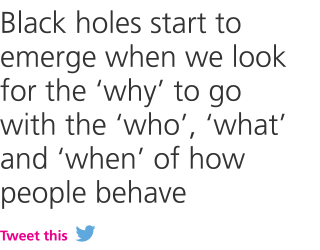The touchpoints revolution has created a big bang of rapidly emerging new data sources – but between these points of light, it’s also created black holes in our understanding that only a re-engineered approach to research can fill.
A new wave of connected touchpoints is taking over from survey-based research as the dominant source of data for brands. The streams of real-time information emanating from these touchpoints tell us exactly who does what and when, not just for a small sample of people but for everybody interacting with them. However,  the touchpoints revolution that is bringing Big Data into being is also revealing Big Data black holes – significant gaps in our understanding that result from the things touchpoints can’t tell us. Filling these black holes is the new mission of research, and it’s a mission that is crucial to brands’ ability to market effectively. Unless we fully understand consumer behaviour in this new, emerging universe, we cannot hope to influence it.
the touchpoints revolution that is bringing Big Data into being is also revealing Big Data black holes – significant gaps in our understanding that result from the things touchpoints can’t tell us. Filling these black holes is the new mission of research, and it’s a mission that is crucial to brands’ ability to market effectively. Unless we fully understand consumer behaviour in this new, emerging universe, we cannot hope to influence it.
 The black holes start to emerge when we look for the 'why' to go with the 'who', 'what' and 'when' of how people behave.
The black holes start to emerge when we look for the 'why' to go with the 'who', 'what' and 'when' of how people behave.  Touchpoints data alone can’t tell you what a person is thinking or feeling when they carry out a particular action. It can’t tell you what their mindset is, what their relationship to your brand is, and whether it’s at all worthwhile spending money on advertising to them. And without this contextual information, all of the other data loses much of its value.
Touchpoints data alone can’t tell you what a person is thinking or feeling when they carry out a particular action. It can’t tell you what their mindset is, what their relationship to your brand is, and whether it’s at all worthwhile spending money on advertising to them. And without this contextual information, all of the other data loses much of its value.
How Big Data black holes form
This is a direct result of the nature of the touchpoint revolution itself. A particular action no longer has a pre-determined meaning as part of a linear path to purchase. One behaviour, like visiting a Nike website, does not automatically lead to another behaviour, such as buying a Nike product. Training algorithms to assume that it does simply blunts your targeting approach, confuses your strategy and wastes your budget.
To understand the real significance of someone’s interaction with a touchpoint, we need to understand that person’s preferences, the triggers for them to make a purchase, and the contexts that play a role in their decision-making. Our Nike website visitor, for example, may be there specifically to buy a pair of Nike running shoes, but they could equally be researching technologies for reducing the risk of shin splints, with no particular interest in the Nike brand or products at all. They could be an existing Nike customer seeking troubleshooting information for the wearable they bought a year ago; a journalist researching the company – or an activist checking on the origin of its products. Taken in isolation, the data generated from this one touchpoint has no way of differentiating between these people with very different relationships to the Nike brand. All too often, it can’t even distinguish whether the visitor is really a human being, as opposed to a bot.
The problems these black holes cause
This lack of contextual understanding creates two types of problems for marketers:
- It undermines the actionability of touchpoints data. Targeting based on behaviour in isolation tends to result in a lot of irrelevant advertising being delivered to the wrong people, with wasted budgets, frustrated consumers and plummeting ROI.
- It makes it difficult to optimise on the basis of touchpoints data.
If marketers are to make strategic decisions about where to spend their budgets, they need a way of assessing what the relative impact of all of their audience’s different touchpoints are. To which channels should they be directing more of their marketing budgets?
Re-establishing a single view of consumers
We gain much from the new streams of data that the touchpoints revolution has provided, but we lose something in exchange: a single-source view of the consumer that allows us to relate the actions they take to the feelings and motivations they say that they have. For all their weaknesses, traditional surveys provided the opportunity to explore the context for actions at the same time as establishing what actions had taken place. This enabled us to segment audiences based not just on what they did, but on the basis of their mindsets and receptivity to brands. We need to re-engineer and scale this form of understanding to capitalise on the flood of data being released by touchpoints. Only by doing so can we fill the Big Data black holes that are emerging.
Getting more value from behavioural targeting
Far from losing relevance in the age of Big Data, the art of segmenting an audience is becoming more valuable and actionable than ever. Once, the segments constructed from surveys were largely imprisoned within research reports and Powerpoint presentations; their value dependent on the ability of media planners to match them to audiences you could actually buy. This involved judgments about whether those segments related to people who watched a particular TV show or read a particular magazine. Today, data management platforms (DMPs) have the potential to create more complete audiences through combining multiple data sources together. Through integrating research-derived segments with touchpoint data, we can identify the behavioural markers that indicate different motivations and mindsets, linking particular patterns of behaviour to what consumers are thinking and feeling. Using look-a-like modeling, we can then turn relatively small segments based on motivations, consumption occasions, needs and preferences into relevant, targetable audiences that can be combined with behavioural data, and therefore targeted at immense scale.
The fact that audience segments could be so much more actionable should encourage marketers to look beyond targeting based solely on behaviour. They should instead start by exploring new ways of understanding their audiences that can unlock growth opportunities when linked to touchpoints data. This could involve identifying those who have spent with a brand in the past but are open to spending more (as TNS worked with Holiday Inn to do, increasing bookings by 514%). It could involve identifying those with the most relevant unmet needs for a new product launch; or those that buy a brand such as Starbucks coffee every morning, but could be persuaded to buy it at lunchtime as well. By identifying how these specific people behave, and when they can be targeted through different touchpoints, we start to fill in the most fundamental Big Data black holes.

Identifying the touchpoints that really make the difference
What of the second big gap in our understanding? The ability to understand which touchpoints actually influence a person’s choices? To start answering this question, we first need a more complete picture of all the touchpoints that are involved in a person’s experience of a brand.
Things are made more complicated by the fact that  our data-driven view of consumers’ digital journeys is far less complete than we would like. Cookies compile information about browsing history and provide a view of the sequence of touchpoints leading up to a purchase, but regulations, device incompatibility and the difficulties of relating cookies to individuals (rather than IP addresses) leave significant gaps in the story. Then there’s the plethora of invisible touchpoints – those that take place offline, and those that take place within walled gardens (such as Facebook), which choose not to share their individual-level data externally.
our data-driven view of consumers’ digital journeys is far less complete than we would like. Cookies compile information about browsing history and provide a view of the sequence of touchpoints leading up to a purchase, but regulations, device incompatibility and the difficulties of relating cookies to individuals (rather than IP addresses) leave significant gaps in the story. Then there’s the plethora of invisible touchpoints – those that take place offline, and those that take place within walled gardens (such as Facebook), which choose not to share their individual-level data externally.
The solution, once again, involves upgrading the traditional techniques of research to infuse them more effectively with the flow of Big Data. Larger and more representative survey panels have a key role to play. When members of these panels are linked to user IDs that record exposure to brands through touchpoints, we are able to explore the impact of those experiences on key brand metrics. This can be done through surveys or by observing the impact on measurable behaviours like sales and site visits. We can then model the likely impact of exposing different audience segments to different combinations of touchpoints.
Engaging with members of a research panel has the additional advantage of making it easier to integrate different forms of data, including those from the web’s walled gardens. By developing new listening techniques (leveraging smartphones to listen to what ads a person is exposed to, for example) we can start to integrate a view of offline touchpoints as well.
A combined mission: towards data agnosticism
The data that we can now source from touchpoints has many advantages over the data we once generated through surveys. It is more representative, less prone to error in identifying who did what and when, far more immediate in providing the information that we need. In isolation, though, it cannot provide the complete, connected view that marketers need of why people behave in the way that they do.
 The brands with the most complete and holistic view of their consumers will increasingly be the brands that execute the most effective marketing over both the long and the short term. They will be able to direct budget towards the people that represent the greatest growth opportunities, and they will be able to feed valid insights from their different touchpoints into both their creative and media planning. To provide this view, researchers must look beyond championing one form of data over another; it is the way their different types of information can be integrated into a single view that ultimately decides how valuable they will be.
The brands with the most complete and holistic view of their consumers will increasingly be the brands that execute the most effective marketing over both the long and the short term. They will be able to direct budget towards the people that represent the greatest growth opportunities, and they will be able to feed valid insights from their different touchpoints into both their creative and media planning. To provide this view, researchers must look beyond championing one form of data over another; it is the way their different types of information can be integrated into a single view that ultimately decides how valuable they will be.










